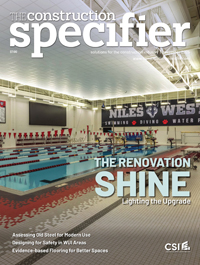The benefits of having turnstiles
| AUBURN UNIVERSITY |
| The optical turnstiles installed at Auburn University display open and closed status lights to indicate which lanes are open for use in the direction of travel. Two exit lanes (left) illuminate a green light and three entry lanes (right) illuminate a red light.
Auburn University (Auburn, Alabama) incorporated optical turnstiles with barriers to control access into the university’s new $72 million, 22,296-m2 (240,000-sf) Recreation and Wellness Center. Auburn replaced originally installed equipment with optical turnstiles and a tandem motorized gate, which blended well with the recreation center’s environment and provided reliable access control. The university installed five optical turnstiles—three for entering and two for exiting. Users present ID cards at designated entry-only turnstiles to access the facility. To exit, users pass through designated exit turnstiles, which open automatically as users leave. The tandem motorized gate has an 1828-mm (72-in.) passage width, allowing large equipment and large groups to enter and exit the facility. |
Selecting the appropriate turnstile
Turnstiles fall into three primary categories:
- optical and barrier optical;
- full-height; and
- waist-high.
Depending on the specific application, a different type of turnstile may be preferred. Choosing the right style requires consideration of various factors, including:
- interior versus exterior use;
- the desired level of security;
- budget;
- necessary features; and
- aesthetic preferences.
Optical turnstiles
Optical turnstiles consist of two cabinets set apart to create a passage lane, which use sensors to detect and track any person passing through. They can operate with or without physical barriers, but when used for security purposes, they typically operate with a motorized barrier. Barrier-free optical turnstiles only ‘sense’ an unauthorized passage; they are generally used for passive security or where an attendant is always present.
Optical turnstiles are ideal for facilities where speed of entry and aesthetics are important, such as corporate lobbies, multi-tenant buildings, university recreation centers, and modern health clubs. Typical applications include main lobby, employee, and elevator bank access points. Advantages of these systems include:
- being aesthetically pleasing for upscale and corporate settings;
- providing bi-directional access control;
- offering various types and heights of barriers;
- tailgating, loitering, and anti-pass back detection; and
- accommodating users with mobility devices.
However, optical turnstiles have disadvantages as well. These include their limitation to indoor use, higher cost than traditional mechanical alternatives, and the lower level of security inherent in barrier-free options.
Full-height
Full-height turnstiles consist of mechanically rotating barriers extending from the floor to the top of the turnstile, similar in structure to a revolving door. Full-height turnstiles can be single units or tandem units. The latter combines two turnstiles operating within a smaller footprint.
Full-height turnstiles are best suited for facilities requiring higher levels of security, especially in unmanned locations. They are commonly used at military bases, nuclear and energy facilities, distribution warehouses, and manufacturing facilities. Full-height turnstiles are the best option for perimeter control, fence line security, and parking lot access. These mid-range-cost systems have various benefits, including:
- maximum security;
- bi-directional access control; and
- usability in outdoor environments.
However, full-height turnstiles are large and obtrusive. Further, they require the addition of a gate or door to accommodate users with mobility devices.








